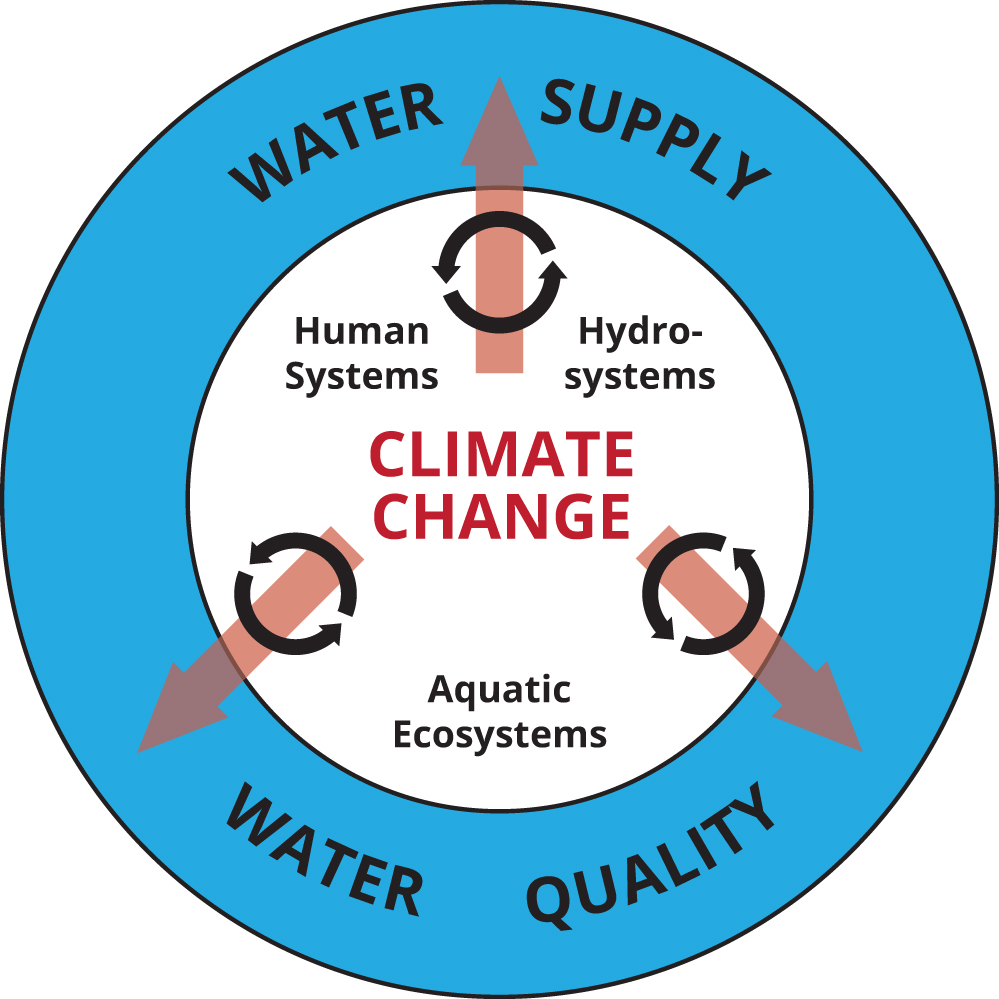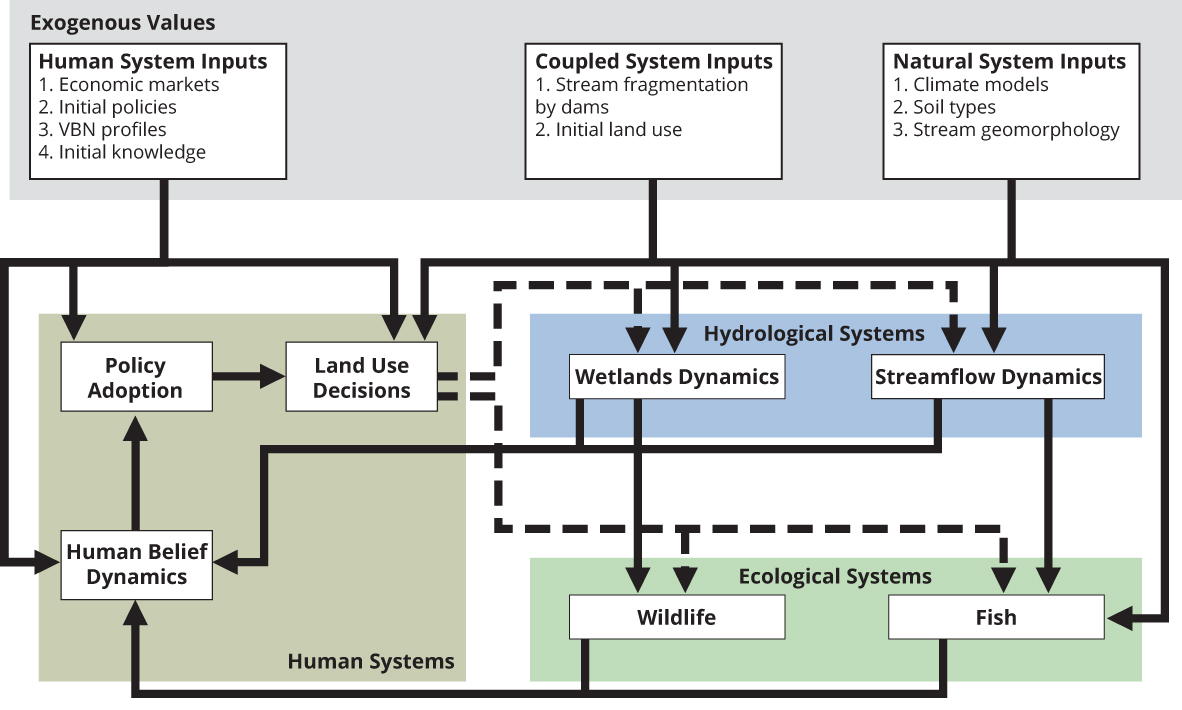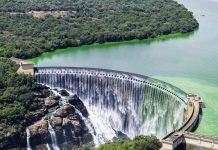Experts from Stroud Water Research Center and Kansas State University highlight the importance of addressing today’s freshwater resource problems and how to achieve sustainable watershed management
Freshwater resource problems are ubiquitous across the globe despite decades of focused watershed management efforts targeting drinking water treatment, water use efficiency and point-source pollution reductions. Severe challenges remain with respect to more diffuse and less easily treated problems that begin with land use and water use decisions by humans living, working, developing and farming watersheds increasingly altered by anthropogenic climate change.
To address today’s freshwater resource problems, we must understand the role of humans in freshwater systems, including their culturally influenced decision-making processes. Integrative analysis of natural and social systems has been an international sustainability science goal for many years. However, full integration in regard to the role of culture is often still missing from the complex water sustainability equation.
Achieving more sustainable watershed management depends in large part on the ability to better understand the social learning processes that drive adaptive environmental decision-making, as well as the causal chains linking culturally influenced environmental values to environmental behaviours. Integrative mechanistic models are needed that account explicitly for human-landscape interactions and incorporate detailed, well-developed, coupled models of hydrosystem, aquatic ecosystem, and human system responses to changing climate (Figure 1).
Our research approach interactively couples mechanistic models of three systems – the hydrosystem, the human system, and the aquatic ecosystem – controlling water supply and water quality in the Central Great Plains of North America, a region with longstanding water quality and quantity concerns. In this arid, highly erodible and agriculturally intensive region, historical natural climate fluctuations have been extreme, and the coupling between the dynamic climate and human systems is close, as witnessed during the Dust Bowl environmental disaster of the 1930s.
This classic example of the intersection among climatic variables, human land use, and unexpected societal impacts illustrates the economic, demographic, and cultural consequences for a region and nation when unsustainable land use collides with unanticipated climatic change.
We demonstrate our integrative modelling framework in the study of a coupled human and natural system in a surface water-dependent agricultural watershed with a highly climate-sensitive surface water flow regime influenced by human-induced land-use and climate change. The hydrosystem serves as the foundation of our model, which focuses on integrating climate, ecosystem and human decision scenarios as boundary conditions for a watershed response model. This enables us to predict future surface water regimes that inform an aquatic ecological model.

Since cultural influences can drive people to either adopt or reject sustainability policies, our human-systems model empirically includes culture. Humans use culture to learn and inform their decision-making processes, but human culture is often seen as too difficult to incorporate into environmental system models.
At its most fundamental, culture is comprised of shared values, beliefs, and norms through which humans visualise, interpret, or assign meaning to actions, concepts, and their environments. Despite this complexity, developing mechanisms to empirically model the cultural influences that drive region- or community-specific responses to management efforts is critically important.
We model policy decision-making processes grounded in culture within a framework of coupled human and natural systems, quantifying cultural influence using the Values-Beliefs-Norms (VBN) framework informed by an extensive survey of the local population. Within an agent-based model, agents vote to adopt or reject environmental policies.
Heterogeneity among agents is derived from demographics, VBN factors, and the environment. Each human agent is populated by attributes extracted from an extensive survey of the local population. Attributes include demographic characteristics (gender, education, income, age, and occupation), values characteristics (altruistic toward humans, altruistic toward biodiversity, traditional, self, and openness to change), environmental worldviews, political ideology, and environmental knowledge.
The agents’ decision-making processes are informed by cultural, hydrological, and aquatic biodiversity models. The fully integrated model (Figure 2) is then used to evaluate whole-system response to climate variation scenarios derived from historical data and downscaled climate projections. This integrative model represents a functional coupling of natural and human systems, allowing for biophysical feedbacks to directly affect agents’ decision-making processes and enabling us to evaluate the sustainability outcomes delivered by different policy scenarios.
Our findings demonstrate that policy support is grounded in cultural values, and cultural differences explain preferences for conservation policies designed to conserve and protect water resources and aquatic ecosystems. The array of values invoked to make decisions about policies, and the social-psychological pathways linking values to policy support can vary across policies and types of agents (e.g. farmers and non-farmers).

In contrast, some human system factors, such as financial obligation, are the strongest and most consistent explanation of support for conservation policies among members of both groups. These dynamic linkages between cultural and environmental factors reveal new pathways for actions that support sustainability.
Our results indicate resistance to environmental policy, suggesting that the local cultural framework may result in rejection of sustainability policies and prevention of needed support even under potentially extreme climate conditions.
However, our model also showed that the best opportunities for policy acceptance immediately follow extreme events. This underlines the need for influencing culture and pro-environmental behaviour via interventions and monitoring to benefit from the increased acceptance of environmental policies during and immediately following severe environmental conditions. This work provides the foundation necessary for future research to explore rich questions about coupled system dynamics and sustainability policy.
Funding Acknowledgement:
This work was supported in part by the National Science Foundation, Dynamics of Coupled Natural and Human Systems Program, Award #1313815.
References
Caldas, M et al. 2018. An interdisciplinary approach to water management. Scientia.
Chatterjee, S., et al. 2018. Projected climate change impacts on hydrologic flow regimes in the Great Plains of Kansas. River Res Applic. 1–12. https://doi.org/10.1002/rra.3249
Caldas M., et al. 2015. Opinion: Endogenizing culture in sustainability science research and policy. Proceedings of the National Academy of Science of the United States of America 112(27): 8157–8159.
Sanderson, M., et al. 2017. Bringing the “social” into sociohydrology: Conservation policy support in the Central Great Plains of Kansas, USA. Water Resources Research 53 (8), 6725-6743.
Sanderson, M. et al. 2018. Explaining Climate Change Beliefs in an Agricultural Context: The Role of Held Values. Climatic Change, 150(3-4): 259 – 272.
Stroud Water Research Center
https://stroudcenter.org/
Authors:
Melinda Daniels, Marcellus Caldas, Jessica Heier Stamm, Matthew Sanderson, Jason Bergtold, Gabriel Granco, Martha Mather, Joeseph Aistrup, David Haukos
*Please note: This is a commercial profile











